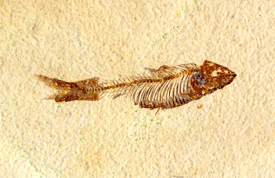Once the hammers of geologists began turning up startlingly clear fossils like the one shown here, it became much harder for scientists, naturalists, and the general public to sustain the idea of a neatly organized creation that had popped up during seven days in the year 4004 BC (the date established on Biblical authority by Bishop Ussher of Ireland). The geological record offered compelling evidence of an earth that was constantly undergoing changes of many kinds, from the slow motions of erosion and sedimentation to the cataclysmic upheavals of volcanoes and landslides. Charles Lyell’s Principles of Geology (1830-33) agreed with James Hutton that the geological forces of the ancient past were identical to those still operating. This meant that while millions of years might have been necessary to bring about geological phenomena (metamorphic and igneous rock, fossilized organisms), it was likewise true that no formation on earth was permanent. Fossils contributed directly to debates about evolution and extinction, two concepts that were clearly not in keeping with the Biblical account of creation. Some natural theologians went so far as to argue that God had placed fossils in the earth in order to test the faithful. Others claimed that these curious objects were the remains of antediluvian giants and creatures that did not make it onto Noah’s ark. For poets, discoveries in geology and earth science also made it much harder to find metaphoric images of natural stability. “That sturdy mountain?”; well, it won’t last. “That mighty river?”; it wasn’t here a million years ago, and it won’t be in this location a million years from now.

Fossils like this revealed that life was much older than had been previously believed, since eons would have been required to turn fish into fossils and bones into stone
In 1797, one of Coleridge’s metaphors for the human imagination derives from his image of a mountain throwing up a raging river and the gigantic rocks on its banks:
And from this chasm, with ceaseless turmoil seething,
As if this earth in fast thick pants were breathing,
A mighty fountain momently was forced;
Amid whose swift half-intermitted burst
Huge fragments vaulted like rebounding hail,
Or chaffy grain beneath the thresher’s flail:
And ‘mid these dancing rocks at once and ever
It flung up momently the sacred river.
(“Kubla Khan,” published 1816, ll.17-24)
William Hamilton Drummond published The Giant’s Causeway, A Poem in Belfast in 1811. His “epic” offers a lyrical history of Ireland based around the giant polygonal basalt formation along the north Antrim Coast, with copious notes on earth science and mythology. By 1850, Tennyson’s personified “Nature” sounds like a Victorian geologist hammering away at a fossil-filled rock face: “From scarpèd cliff and quarried stone / She cries, ‘A thousand types are gone: / I care for nothing, all shall go’.” (In Memoriam, 56). The dynamic organicism that characterized the emerging science of biology thus found parallels in the canyons, cliffs, and waterfalls. The world beneath human beings was suddenly moving and shifting, always changing. The static world of biblical history would never be the same again (A.N.)
